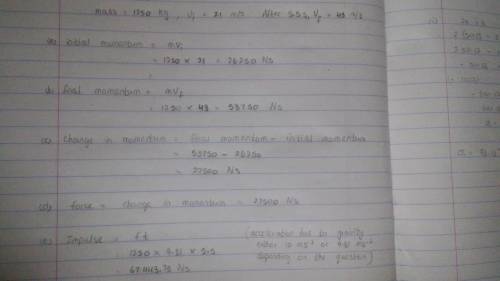
Physics, 24.09.2019 19:30 destinyranson
Acar with a mass of 1250kg has an initial velocity of 21m/s. after 5.5s, it has a velocity of 43m/s.
a) what was its initial momentum?
b) what is its final momentum?
c) what is its change in momentum?
d) what is the magnitude of the force the car’s engine exerts?
e) what is the impulse for this problem?

Answers: 1


Another question on Physics

Physics, 21.06.2019 18:50
The summit of chimborazo, in ecuador, which is at a distance of about 6,384 km from the earth's center. the bottom of the mariana trench, in the western pacific ocean, which is nearly 6,370 km from the center of the earth. on the surface of earth on the equator line.
Answers: 1

Physics, 22.06.2019 01:10
The x-coordinate of a particle in curvilinear motion is given by x = 3.1t3 - 4.9t where x is in feet and t is in seconds. the y-component of acceleration in feet per second squared is given by ay = 2.3t. if the particle has y-components y = 0 and vy = 5.0 ft/sec when t = 0, find the magnitudes of the velocity v and acceleration a when t = 1.8 sec. sketch the path for the first 1.8 seconds of motion, and show the velocity and acceleration vectors for t = 1.8 sec. answers: v = ft/sec a = ft/sec2
Answers: 2

Physics, 22.06.2019 14:30
Explain what it means to view something from a frame of reference. provide an example that illustrates your explanation. (4 points)
Answers: 1

Physics, 23.06.2019 00:00
Why does a collision with an airbag cause less damage than a collision with a steering wheel
Answers: 1
You know the right answer?
Acar with a mass of 1250kg has an initial velocity of 21m/s. after 5.5s, it has a velocity of 43m/s....
Questions

Mathematics, 16.04.2020 21:34



History, 16.04.2020 21:34




History, 16.04.2020 21:34

Business, 16.04.2020 21:34








Mathematics, 16.04.2020 21:34

Biology, 16.04.2020 21:34

Mathematics, 16.04.2020 21:34

Mathematics, 16.04.2020 21:34




